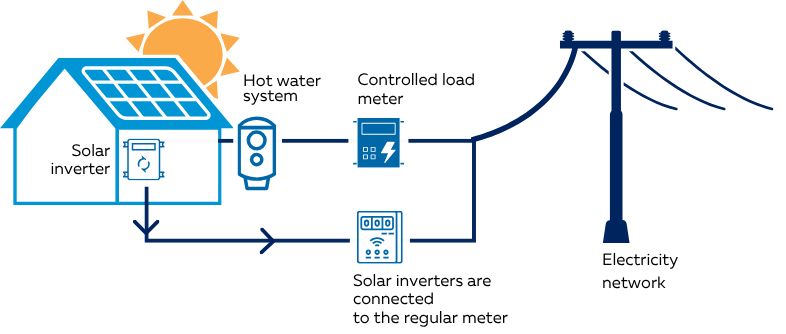What is a controlled load tariff?
Controlled loads refer to tariffs for electricity supplied via separate wiring from the rest of the home. Typically, this is for hot water heating but can be used for other things like electric vehicle charging.
Why use a control load tariff?
Controlled load tariffs offer customers a way to save money on their energy costs for energy hungry appliances when demand on our network is at its lowest.
Because controlled loads are separate and don’t need a constant power supply, electricity can be supplied for a limited number of hours each day at a very low cost. This is usually at off-peak times, and the times electricity is available are known as “switching times”. By shifting certain loads to off-peak times, controlled loads help to manage demand making the network run more smoothly and efficiently. Around half a million Ausgrid customers have controlled loads.
What’s changing with controlled loads?
In the past a controlled load was designed to use cheap off-peak power overnight. Now thanks to the abundance of solar generation, electricity is cheaper during daylight hours. Because of this, Ausgrid has changed controlled load switching times for customers with a smart meter.
The updated times are designed to soak up solar energy production during the day, giving customers more flexibility in how they use the controlled load tariffs. Controlled load tariffs typically have a lower energy component than other tariffs, providing an opportunity for customers to reduce their energy bills.
To be able to access these tariffs, the appliance must be permanently connected to the controlled load circuit.
Ausgrid offers two types of tariffs
EA030 controlled load 1, suitable for large electric hot water systems (250 - 630L)
Controlled Load 1 tariff is available for supply that is usually connected for at least six hours duration within any 24 hour period: midnight to midnight. Controlled Load 1 switching times may be varied at the discretion of Ausgrid.
EA040 controlled load 2, suitable for smaller electric hot water systems (100 - 250L)
The EA040 Controlled Load 2 tariff is available for supply that is usually connected for at least sixteen hours duration within any 24 hour period: midnight to midnight, including at least four hours between 7 am and 5 pm.
For technical and eligibility criteria please see Appendix B - ES7 Network Price Guide. In July 2024 Ausgrid introduced changes to switching times to make use of solar energy during the day for Controlled Load 1 (EA030). Customers on Controlled Load 2 (EA040) already had access to these switching times.
EVs and controlled loads
Customers are already able to charge their EVs using controlled load tariffs. This provides a cost-effective option for EV owners who are willing to use a secondary circuit for their charging.
How do I get a controlled load?
The first step is to contact your retailer who can tell you if you are already on a controlled load tariff and help you add one if needed. Looking at your bill is another way to check if you already have a controlled load tariff.
Because controlled load tariffs operate on a separate circuit you may need an electrician to set it up if your home does not already have one. The diagram below shows how controlled load and solar are connected to the meter.





